For Hometowns to Hollywood’s Celluloid Road Trip Blogathon

Show Boat’s Origins
The role of Julie LaVerne in MGM’s lavish Technicolor adaptation of the beloved stage musical Show Boat is one of Ava Gardner’s most well-known roles. Set aboard a Mississippi steamboat called the Cotton Blossom, the 1951 film version is based on Edna Ferber’s 1926 novel and the 1927 Broadway musical adaptation by Jerome Kern and Oscar Hammerstein II. In her autobiography, Ava Gardner summarized the plot of the novel as “dealing with three generations of the Hawks family, from Captain Andy to daughter Magnolia to granddaughter Kim, all of whose lives revolve around a show boat cruising up and down the Mississippi in the late nineteenth century.”[1]
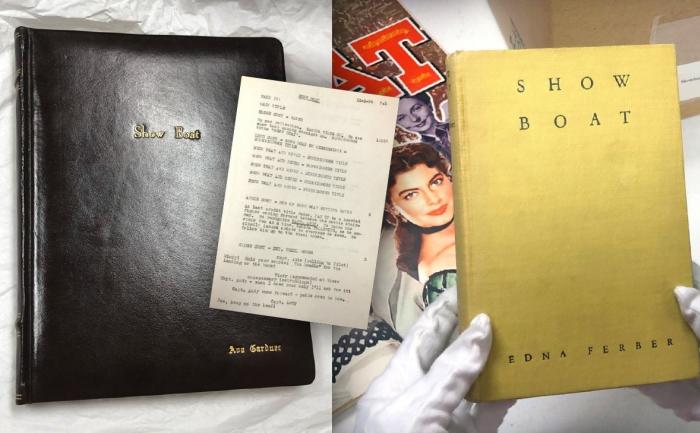
Ava Gardner owned this leather-bound script from the 1951 film adaptation of the 1926 novel by Edna Ferber. Ava also owned this copy of the novel. These items are now part of the Ava Gardner Museum's collection.
Show boats were floating theaters that journeyed along rivers in the United States from the 1870s to the 1930s with the performers living on board. The traveling troupes of actors and musicians brought musical comedy and dramatic theatrical productions to small towns that were otherwise isolated from access to many popular entertainment options of the day. The novel, stage productions, and subsequent film adaptions of Show Boat brought this unique facet of American culture to life. Although the plot of Show Boat was set on the Mississippi River, the origins of the story have strong connections to North Carolina.
When Pulitzer Prize winning writer Edna Ferber learned of the existence of show boats, she found herself immediately drawn to the subject matter. She said of them: "Here, I thought, was one of the most melodramatic and gorgeous bits of Americana that had ever come my way. It was not only the theater – it was the theater plus the glamour of the wandering drifting life, the drama of the river towns, the mystery and terror of the Mississippi itself…I spent a year hunting down every available scrap of show-boat material; reading, interviewing, taking notes and making outlines."[2] As part of her research, Ferber traveled in 1925 to the small river hamlet of Bath in Ava Gardner’s home state of North Carolina. There she spent four days aboard the James Adams Floating Theatre while it traveled through the coastal areas of eastern North Carolina. Ferber described the material she gathered from the trip, especially from her talks with Charles Hunter, the director and chief actor on the James Adams, as "a treasure-trove of show-boat material, human, touching, true."[3] The novel, published in 1926, was an immediate bestseller, landing the number one spot for twelve weeks.
Cue the Music
In 1927, Edna Ferber granted the rights of her story to composer Jerome Kern and lyricist Oscar Hammerstein II. With the backing of noted producer Florenz Ziegfield, they transformed her story into a groundbreaking Broadway musical.
Up to that point in musical theater history, Broadway shows were largely comprised of light-hearted comedies and musical revues. Ferber’s sweeping novel spanned nearly 40 years with an enormous cast of characters that wove in and out of the plot. Kern and Hammerstein worked together tirelessly to retain the epic nature of Ferber’s story and translate its scope to the stage. Their resulting adaptation of Show Boat was wholly innovative for its merging of musical score and narrative plot, “integrating them for the first time to provide a seamless transition from scene to song.”[4]

This soundtrack for the 1951 film adaptation of Show Boat features Ava's singing voice on two tracks, as well as the other famous songs from the music, including "Ol' Man River."
In a 1958 interview Hammerstein said of the process of writing the show and its most famous song: "I thought that we lacked something to make it cohesive. I wanted to keep the spirit of Edna's book, and the one focal influence I could find was the river, because she had quite consciously brought the river into every important turn in the story. The Mississippi. So I decided to write a theme – a river theme."[5] The musical theme Hammerstein described became the song “Ol’ Man River” which is performed by Joe, the show’s principal black character, and is reprised several times throughout the production.
The stage musical also marked one of the first times black and white characters were depicted as equals on the Broadway stage. Critics lauded the show with praise and audiences flocked to see it, making the initial production a huge success with a run of 527 performances.
Bringing the Mississippi to Life on the Big Screen
Adapting the Story
In 1929, producer and founder of Universal Pictures, Carl Laemmle produced the first film adaptation of Show Boat based primarily on Ferber’s novel. The second film version, also from Universal Pictures, was released in 1936 and adapted from Kern and Hammerstein’s stage musical. Producer Carl Laemmle Jr. and director James Whale headed this version, and they chose to cast several actors who had performed in various stage productions of the show, including Irene Dunne, Hattie McDaniel, and Paul Robeson. The Arthur Freed production unit at MGM helmed the 1951 remake. Filmed in vivid Technicolor with extravagant sets and stunning costumes by famed designer Walter Plunkett, director George Sidney led a talented cast including Ava Gardner, Kathryn Grayson, Howard Keel, and William Warfield.
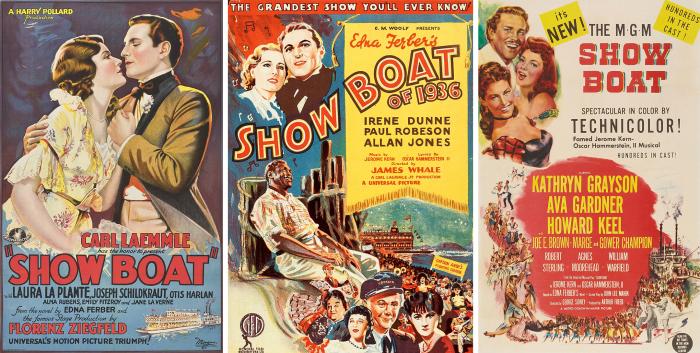
Posters from the three film adaptations of Show Boat.
In order to bring Show Boat to the big screen, all three film adaptations had to address issues in the plot that were often deemed controversial to their contemporary audiences. The novel and musical tackled tough subjects of racial discrimination that were still felt in the United States and especially across The South at the time each adaptation was released. The miscegenation, or interracial relationship, depicted in the story was still illegal in many places as late as 1967 when the Supreme Court struck it down in the landmark case Loving v. Virginia. Despite societal pressures or production code limitations, each film version pushed boundaries and shined light on racial restrictions in the southern United States.
Ava Gardner’s long-time friend and personal assistant Mearene (Rene) Jordan wrote about her impression of Show Boat’s story in the book Living with Miss G: “Show Boat was about the good old paddle-steamers sliding up and down the Mississippi in the days when gentlemen wore top hats, frock coats and striped cravats, and ladies wore crinolines, carried parasols and talked just like Vivien Leigh in Gone With the Wind. At least in MGM films they did. Black laborers, just freed from slavery, pulled ropes and loaded the cotton bales and sang songs like “Ol’ Man River” – ‘body all achin’ and racked with pain,’—which was probably closer to the truth than any other aspect of the movie. For Show Boat was a romantic fairy story hoping to send people home happy with just a little tear in their eye for poor, haunted Julie.”[6]

Ava Gardner as Julie LaVerne in MGM's 1951 Show Boat.
Show Boat includes the story of Julie LaVerne, who, as Rene put it, “was a half-caste—beautiful, desirable, but an outcast in those southern states because there was black blood in her veins. Julie pretended she was white. She married a handsome gambling man who made a living at cards on the paddle boat, Cotton Blossom, and that was her big mistake. Someone told the sheriff about her, and he threw them both off the steamer. Disgraced, her husband abandoned her, and she sank down into alcoholism and poverty.”
Casting the MGM Production
While each production specifically focused on life on the Mississippi River and the unique world of show boat performers in the 19th century, the racial issues they highlighted were deeply ingrained in American society. And, these problems were still very much present in 1951 Hollywood when MGM embarked on their adaptation of Show Boat.

Lena Horne
Arguably, the most controversial issue with the 1951 production of Show Boat happened behind the scenes with the casting of Julie LaVerne. When MGM produced a biographical film about composer Jerome Kern entitled Till the Clouds Roll By (1946), they cast Lena Horne in the role of Julie LaVerne for the 15-minute sequence highlighting music from the Show Boat stage musical. The biopic was edited for southern markets to remove Horne’s numbers, since at the time, film censors in Southern states often banned movies that depicted people of color in equal social situations with whites. Five years later, when the studio cast the feature length film of Show Boat, Horne lobbied to be cast as Julie. Unfortunately, she was not allowed to reprise the role she had previously played due to production code rules that forbade the depiction of interracial relationships. While MGM did fight to keep the miscegenation storyline from the original novel and stage musical, they would not have been allowed to actually have an actress of color appear on screen in a romantic storyline with a white actor.[7] Thus, the role of Julie, a mixed-race singer, went to a white actress instead – Ava Gardner.
Horne was a one-time neighbor of Ava, and they were friends from the beginning of their Hollywood careers through the rest of their lives. She even contributed a chapter to Ava’s autobiography, Ava: My Story, in which she said of Ava, “[She] was like my younger sister; she and I were spiritually akin…[and she] had great inner warmth.” Addressing the issues around the casting of Show Boat and how both actresses we angered by the situation, Horne wrote: “We talked about the nonsense about Show Boat, the fact that she was going to do it, and I wanted it…The [studio’s] reasoning behind it made her angry, for my sake. ‘Forget it’, I’d said. We knew, we understood why it happened. So there was no friction about it. We were both very logical. It was a big laugh.”
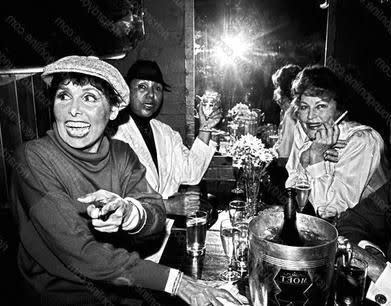
Lena Horne and Ava Gardner enjoying a night out together.
In Living With Miss G, Rene remembered Ava saying, “[Lena is] one of the most beautiful women in the world, inside and out…Of course, Lena should really have been given the part of Julie in the first place. She’s already done a marvelous recording of Show Boat singing Julie’s songs. She’s perfect for it.”
Recreating the Mississippi River
MGM poured its enormous resources into the 1951 film adaptation of Show Boat. Beyond the large cast and dazzling costumes, the studio paid special attention to the production’s largest set piece – the Cotton Blossom. Real show boats of the 19th and early 20th centuries, like the James Adams, were typically large rectangular vessels which were pushed by tugboats. For the 1951 film, the Freed unit wanted something spectacular instead of something historically accurate. The show boat they created was a complete, working paddle boat which cost more than $126,000 to build. During the film’s production it also required repairs totaling $67,000 when an oil tank caught fire.
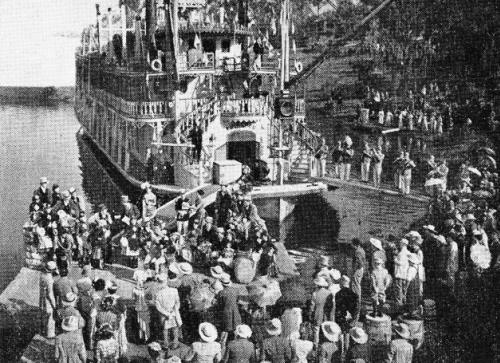
The Cotton Blossom in a scene from the film.
Ava Gardner wrote in her autobiography: “Metro’s ace production people were seeing to the construction of the stern-wheeler Cotton Blossom, which, at a cost of over one hundred thousand dollars, was for quite a while the most expensive single prop ever made. Originally, the film’s exteriors were going to be shot on location around Natchez and Vicksburg, but once it turned out that the weather would be wrong, Metro opted to use its own durable back lot instead. The ten-million-gallon Tarzan Jungle Lake was drained and this enormous triple-decked, one-hundred-seventy-one-foot-long, fifty-seven-foot-high boat was built on top of metal pontoons, so it could actually float up and down the back-lot version of the Mississippi.”[8]
The Tarzan Jungle Lake that Ava referenced was originally used for MGM’s series of twelve Tarzan films throughout the 1930s and 1940s starring Olympic athlete-turned-actor Johnny Weissmuller. Howard Keel, who played Gaylord Ravenal in the 1951 film, suggested in his autobiography Only Make Believe: My Life in Show Business that filming on the Mississippi River was considered to be too expensive, in addition to the weather problems that Ava cited.
The film’s signature set piece of the Cotton Blossom featured prominently in MGM’s opening night event for the film. Rene recalled the premiere of Show Boat, which was held at the Egyptian Theater in Hollywood: “Bales of cotton were stacked all over the foyer, and little black children danced on them wearing straw hats and gingham dresses. One of the staterooms of the Cotton Blossom had been reproduced so we could feel as if we were on a voyage down the Mississippi River. I can tell you, Hollywood in those early fifties was pure bunkum.”
According to Keel’s book, the Cotton Blossom was left on the MGM backlot after the film’s completion, not to be rediscovered until the 1970s.[9] The boat was sold in 1973 to the owner of the Worlds of Fun amusement park in Kansas City, Missouri and relocated there for permanent display. The boat was leveled in 1995 to make room for new park attractions.
Impact of Film on Ava’s Career
For American audiences, Ava’s role in Show Boat marked the first time she appeared in a feature film role in color. (Her film Pandora and the Flying Dutchman was shot in Technicolor but its release was held in the US until after Show Boat’s premiere. International audiences saw her in color in Pandora first.) Although she only appears in 30 minutes of the finished film, Show Boat cemented Ava’s star status, and the 1950s saw her become one of the most sought-after actors in Hollywood. She appeared in a number of her most well-received films after Show Boat including Mogambo (1953) and The Barefoot Contessa (1954).

Publicity materials for Show Boat in the collection of the Ava Gardner Museum.
One of Ava’s biographers, Doris Rollins Cannon, wrote in her book Grabtown Girl: “Full stardom came to Ava in 1951 with her appearance as the tragic and beautiful Julie LaVerne in the musical Show Boat…[It] would become [one of] the biggest grossing film[s] of 1951, and Ava would be widely hailed for her performance.”[10] After the huge success of Show Boat, Ava was even featured on the cover of Time magazine.
Lasting Legacy
While Edna Ferber was researching her novel in Bath, three-year-old Ava Lavinia Gardner was growing up near another North Carolina river community, the town of Smithfield in Johnston County. Born into a rural farming family, Ava was the youngest of seven children. Her rise from a small-town country girl who loved running around barefoot to a glamorous Hollywood star is the stuff of legend.
In 1951, Ava’s star was well on the rise when she was selected for the role of Julie LaVerne in MGM’s remake of Show Boat. The studio dramatically reworked the role of Julie LaVerne, enlarging it to accommodate a star of Ava’s growing stature and prominence. Although her singing voice was dubbed over by Annette Warren for the theatrical release, her natural earthiness and roots in the rural south, made her suited for the role of a lovelorn actress dealing with the societal prejudices of 19th century southern America.
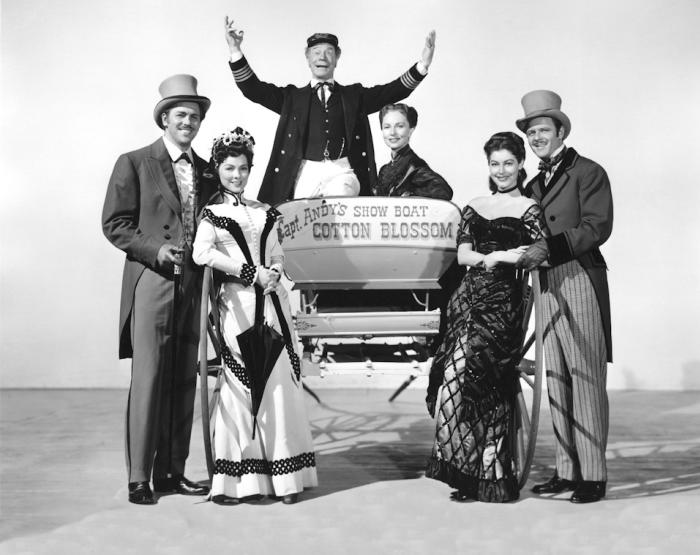
Cast of Show Boat (1951).
With veteran actors like Joe E. Brown and Agnes Moorehead as well as contemporary musical film stars Howard Keel, Marge and Gower Champion, and Kathryn Grayson, another North Carolina native, rounding out the cast, Show Boat (1951) was successful at the box office and with critics. The film was nominated for two Academy Awards: Best Cinematography, Color and Best Music, Scoring of a Musical Picture.
Ironically, the world depicted in the film was partly brought to an end itself by the rise of the motion picture industry. By the time the James Adams Floating Theatre was destroyed by fire in 1941, the era of show boats had ended, with Hollywood dominating the entertainment industry. The beloved story of Show Boat and its lasting legacy lives on today, immortalized forever in the printed novel, Broadway and touring stage productions, and three very unique film adaptations. For Ava’s part, fascinating details about her experiences working on Show Boat and artifacts from the film production are part of the collection of the Ava Gardner Museum which operates in downtown Smithfield, NC.
[1] Ava Gardner, Ava: My Story (New York: Bantam, 1990), 140-141.
[2] Edna Ferber, A Peculiar Treasure (New York: Doubleday, 1960), 297–304.
[3] Ibid.
[4] Nina Totenberg, “'Show Boat' Steams On, Eternally American,” NPR, https://www.npr.org/2013/05/07/181901827/show-boat-steams-on-eternally-american, accessed December 10, 2020.
[5] Ibid.
[6] Mearene Jordan, Living With Miss G, (Smithfield, NC: Ava Gardner Museum, 2012), 60.
[7] “Musical Monday: Show Boat (1951),” Comet Over Hollywood, https://cometoverhollywood.com/2019/01/28/musical-monday-show-boat-1951/, accessed December 10, 2020.
[8] Gardner, 143.
[9] “Musical Monday.”
[10] Doris Rollins Cannon, Grabtown Girl, (Asheboro, NC: Down Home Press, 2001), 92.





